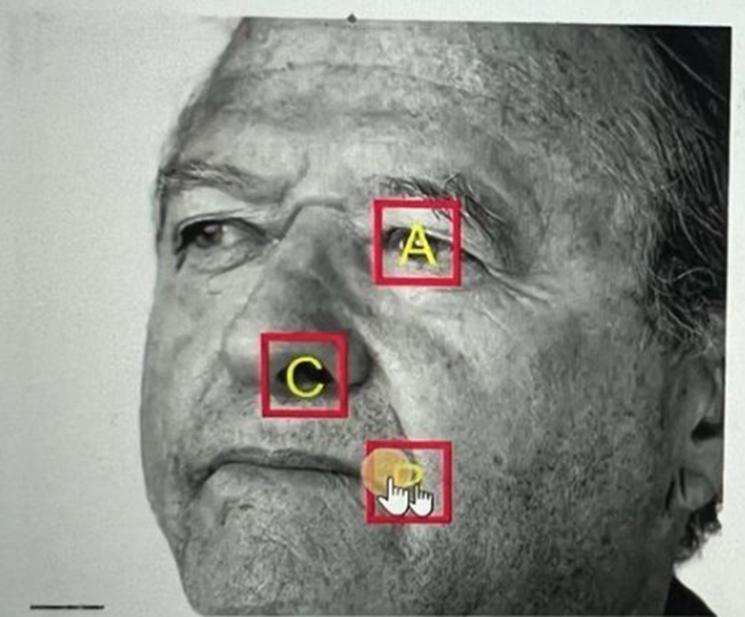A nurse is collecting data from a client who has iron deficiency anemia. Which of the following locations should the nurse monitor for the clinical manifestation of cheilosis? (You will find hot spots to select in the art work below. Select only the hotspot that corresponds to your answer.)

A
B
C
The Correct Answer is B
Choice A: The lower eyelids
The lower eyelids are not typically associated with cheilosis. Cheilosis, also known as angular cheilitis, is an inflammatory condition that affects the corners of the mouth, not the eyelids.
Choice B: The corners of the mouth
Cheilosis, also known as angular cheilitis, is an inflammatory condition that affects the corners of the mouth. It typically presents as erythema, scaling, fissuring, and ulceration. In patients with iron deficiency anemia, angular cheilitis can be a clinical manifestation. Therefore, a nurse should monitor the corners of the mouth in a client who has iron deficiency anemia for the clinical manifestation of cheilosis.
Choice C: The anterior nares
The anterior nares (nostrils) are not typically associated with cheilosis. Cheilosis, also known as angular cheilitis, is an inflammatory condition that affects the corners of the mouth, not the nostrils.
Nursing Test Bank
Naxlex Comprehensive Predictor Exams
Related Questions
Correct Answer is D
Explanation
Choice A reason: Applying lotion between the toes is not recommended for clients with diabetes as it can lead to moisture buildup and infection.
Choice B reason: Wearing open toed shoes is not recommended for clients with diabetes due to the risk of injury to the feet.
Choice C reason: Rounding the corners of toenails can lead to ingrown toenails, which is a risk for clients with diabetes.
Choice D reason: Wearing cotton socks is recommended for clients with diabetes as they allow the feet to breathe and reduce the risk of fungal infections.
Correct Answer is C
Explanation
Choice A reason: Flexing toes when applying stockings is not a recommended practice as it does not ensure proper application.
Choice B reason: Rolling down knee-high stockings can impede blood flow and is not recommended.
Choice C reason: Reapplying the stockings before getting out of bed is correct to ensure they are worn during periods of immobility to prevent deep vein thrombosis.
Choice D reason: Thigh-high stockings should not reach just above the gluteal folds as this may indicate they are too short and could impede circulation.
Whether you are a student looking to ace your exams or a practicing nurse seeking to enhance your expertise , our nursing education contents will empower you with the confidence and competence to make a difference in the lives of patients and become a respected leader in the healthcare field.
Visit Naxlex, invest in your future and unlock endless possibilities with our unparalleled nursing education contents today
Report Wrong Answer on the Current Question
Do you disagree with the answer? If yes, what is your expected answer? Explain.
Kindly be descriptive with the issue you are facing.
